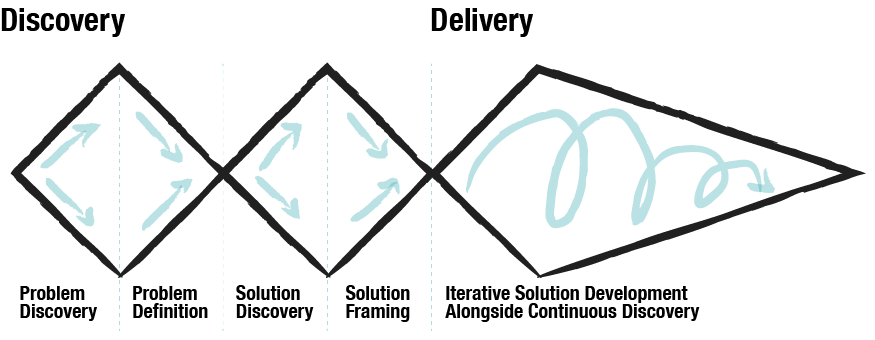You are inspired to use AI: Now what?
Welcome to Part 4 of our comprehensive 6-part series, Beyond Buzzwords: Finding your Purpose for AI, written together with data science expert Noelle Saldana.
A framework for curating meaningful applications of AI
Groundbreaking inventions are famously never the first idea someone has had. Think of penicillin, sticky notes, or Coca-Cola. These products’ inventors were searching for something else when they stumbled upon paradigm-shifting inventions.
“One sometimes finds what one is not looking for. When I woke up just after dawn on September 28, 1928, I certainly didn't plan to revolutionize all medicine by discovering the world's first antibiotic, or bacteria killer. But I suppose that was exactly what I did.” - Alexander Fleming Wikipedia
The point we’re trying to make is not that great discoveries only happen by accident, but that there’s magic (and great gains) that happen in the creative and experimentation process. People should not plough ahead with the first idea or solution or hack, as they are likely missing the bigger opportunity.
A pattern that’s often seen in tech, and AI especially, is companies adopting product trends for the sake of parity with the market when it is ultimately an ill-fitting or unsustainable choice. How many products today have an AI assistant that doesn’t actually help their customers solve their problems?
It’s most powerful to come up with your own ideas that are suited for your product and your unfair advantage. When we’re dealing with a brand-new technology like AI, you can apply the design process of “go wide, then decide.” Zendesk’s triple diamond offers a simple visualisation of this approach.
Continuous design process, based on Zendesk’s triple diamond illustration.
Going Wide
Going “wide” is a critical time to let our imaginations run free to enable innovation. We can bring in inspiration from unexpected sources and give ourselves the chance to come up with quirky and nonlinear ideas. Taking this approach is what will help us look beyond the obvious and find those ideas that have the potential to truly propel our organisation forward. This is where your team might start to hack together something to explore the possibilities of AI.
“How might we?”
How might AI add value and an unfair advantage to your business? Consider questions like:
What are your strategic goals: Where are you playing and how are you winning? Where do you want AI to help?
What is your company’s expertise and unfair advantage? What are you known for? What do customers expect from you? What opportunities would AI open for you?
What are you solving for? Which problems or pain points are you addressing? How is AI enhancing that?
…Then Decide
After you have generated ample possibilities, you have to be smart and deliberate about how you focus on which ideas are the most valuable and realistic to pursue.
First and foremost: Is there AI that exists that solves, or partially solves, the problems you want to solve? Do you have the data to support the AI? If either does not exist yet, are you willing to invest in generating it yourself?
Once you limit your ideas to those that are AI and data ready, we recommend prioritising the evaluation of solutions where you can quickly and cheaply learn if you’re solving a valuable problem.
A valuable problem typically is:
problem/solution
valuable and usable for your (intended) customers (product/market)
can scale that into a sustainable business model
can be profitable
Consider questions like:
Feasibility: Which ideas that you’ve generated look the most interesting? Can you come up with lightweight experiments to quickly determine if they’re worth pursuing?
Ethics: What are the ethical implications of the solutions you’re considering?
Positioning: Would this direction make sense to your customers? Is it something they would trust you to handle?
At the end of this process, you should have a short list of ideas that you can move forward with. We understand this can be uncomfortable. We place so much emphasis on productivity and execution in the business world. It is easy to fall into the trap of productionising an half-baked idea. Someone will create a simple prototype on-demand and use that to quickly get buy-in, but later suffer the consequences when that does not make a good product.
You need to have a mindset of learning and iterating in a range of short and longer-term bets.
When you run your experiments and pilots, what do you discover? How can you apply that to the next round and make it better?
This is a perfect opportunity to take a page from the design studio playbook, where you create opportunities for exploration, learning, and play (along with rigour and pragmatism).
This is part 4 in the series. Read on:
Part 1: Beyond Buzzwords: Finding your Purpose for AI
Part 2: AI Hype is New, Our Reaction To It Is Not
Part 3: Is the product you’re building a good candidate for AI?
Part 4: You are inspired to use AI: Now what?
Part 5: Your AI investment = (AI needs) + (the necessary team)
Part 6: Strategies for successfully integrating an AI practice into your org


